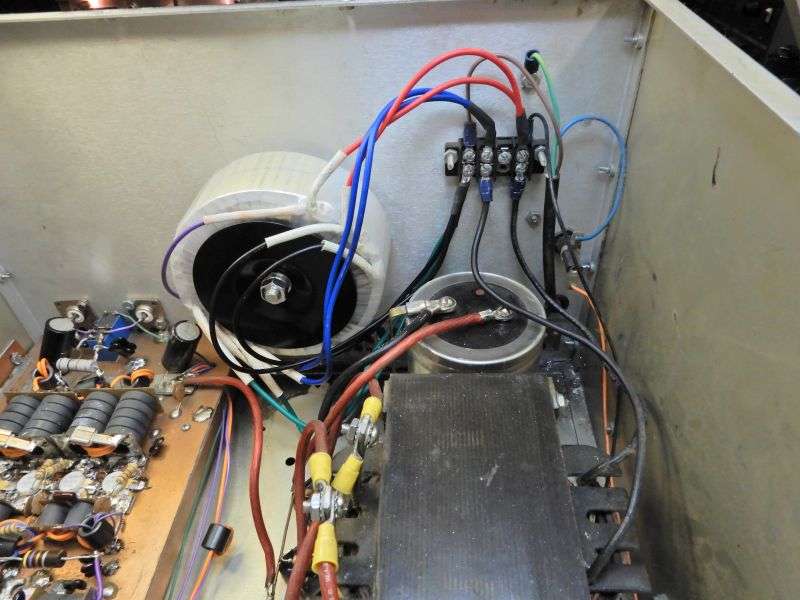It's drop back and punt time.
I started to write up a "how-to" for reducing the suicidal 20-plus Volt DC supply voltage inside a 'competition'-type solid-state base amplifier.
Yes, you get more power from the transistors this way. But the "KBK" rating comes way, way down.
As in "Keys Between Kabooms".
I like to keep that number as high as I can get it. A 20-Volt power supply only qualifies as assisted suicide for the RF power transistors.

We dropped the 120-Volt input to the transformer in this box with a 20-Volt transformer wired to oppose 20 of the 120 Volts. This way only 100 Volts AC reaches the big, black power transformer. Cuts that 20 Volts down to about 16.
Of course, it's an UNregulated supply, and sags to about 12 Volts DC under load. The thing still puts out 500-Watt peaks. Enough for this guy, anyway.
But I got bogged down explaining how a 'buck' winding works in series with another transformer winding.
I should probably track down a YT vid with a nice, complete visual explanation of how you can turn 120 Volts AC into 100 Volts AC with a 20-Volt transformer secondary.
Or go back to trying to do it myself.
I find I didn't really shoot enough step-by-step pics to make this a "do it this way" kind of explanation.
But I will say that the white doughnut in the picture is a toroid transformer that steps 120 Volts down to 20 Volts. The transformer comes from Antek, and cost 40 bucks with shipping. Suicide prevention doesn't come much cheaper than that.
The buck winding should always have a current rating equal to the current draw of the big transformer you're dropping the voltage for. This amplifier won't draw more than 10 Amps from the 120-Volt wall outlet, so a 20-Volt 10-Amp transformer should do the job.
We used an Antek AS-2220. It has two 115-Volt primary windings. We wire them in parallel, to connect where the 120 Volts originally feeds into the big transformer. The two 20-Volt secondary windings get wired in parallel, to get the 10-Amp rating.
Here's a link to Antek's web page for that part: http://www.antekinc.com/as-2220-200va-20v-transformer/
And here's where I should have shot more pics.
And where explaining how to get that winding phased correctly is done. Get it backwards, and you'll end up boosting the line voltage to the big transformer, not reducing it.
But yeah, this trick works.
Gotta find a clear explanation to show what's going on that I can borrow and use for that.
73
I started to write up a "how-to" for reducing the suicidal 20-plus Volt DC supply voltage inside a 'competition'-type solid-state base amplifier.
Yes, you get more power from the transistors this way. But the "KBK" rating comes way, way down.
As in "Keys Between Kabooms".
I like to keep that number as high as I can get it. A 20-Volt power supply only qualifies as assisted suicide for the RF power transistors.

We dropped the 120-Volt input to the transformer in this box with a 20-Volt transformer wired to oppose 20 of the 120 Volts. This way only 100 Volts AC reaches the big, black power transformer. Cuts that 20 Volts down to about 16.
Of course, it's an UNregulated supply, and sags to about 12 Volts DC under load. The thing still puts out 500-Watt peaks. Enough for this guy, anyway.
But I got bogged down explaining how a 'buck' winding works in series with another transformer winding.
I should probably track down a YT vid with a nice, complete visual explanation of how you can turn 120 Volts AC into 100 Volts AC with a 20-Volt transformer secondary.
Or go back to trying to do it myself.
I find I didn't really shoot enough step-by-step pics to make this a "do it this way" kind of explanation.
But I will say that the white doughnut in the picture is a toroid transformer that steps 120 Volts down to 20 Volts. The transformer comes from Antek, and cost 40 bucks with shipping. Suicide prevention doesn't come much cheaper than that.
The buck winding should always have a current rating equal to the current draw of the big transformer you're dropping the voltage for. This amplifier won't draw more than 10 Amps from the 120-Volt wall outlet, so a 20-Volt 10-Amp transformer should do the job.
We used an Antek AS-2220. It has two 115-Volt primary windings. We wire them in parallel, to connect where the 120 Volts originally feeds into the big transformer. The two 20-Volt secondary windings get wired in parallel, to get the 10-Amp rating.
Here's a link to Antek's web page for that part: http://www.antekinc.com/as-2220-200va-20v-transformer/
And here's where I should have shot more pics.
And where explaining how to get that winding phased correctly is done. Get it backwards, and you'll end up boosting the line voltage to the big transformer, not reducing it.
But yeah, this trick works.
Gotta find a clear explanation to show what's going on that I can borrow and use for that.
73
